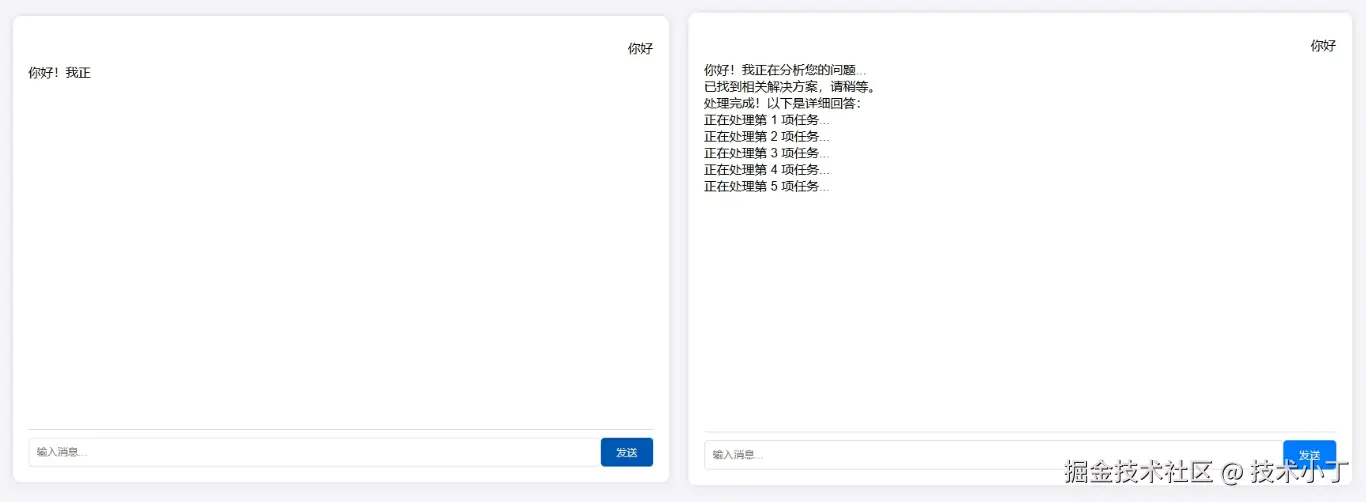拿平时大家写的 for 循环举例。像 go 你可以写两个 go 每个里面各写一个循环同时输入,你可以看到输出是交替。在过去的php版本中,如果只开启一个 cli 写多个 for 循环,那么他的输出一定是顺序的。无法做到交叉输出(也就是无法在第一个循环中执行若干次后,让b再执行,b执行一段时间后,再让A执行)。
现在借助 fiber 我们也可以实现这种操作。
下面这段代码就可以做到两个循环交叉执行。甚至可以控制两个程序执行的频率(比如A执行3次,B执行一次这样分配)
|
1 2 3 4 5 6 7 8 9 10 11 12 13 14 15 16 17 18 19 20 21 22 23 24 25 26 27 28 29 30 31 32 33 34 35 36 37 38 39 40 |
<?php $t1 = false; $t2 = false; $reg = []; $reg[] = new \Fiber(function () use (&$t1) { for ($i = 1; $i < 10; $i++) { echo $i; echo PHP_EOL; \Fiber::suspend();
} $t1 = true; });
$reg[] = new \Fiber(function () use (&$t2) { for ($i = 1; $i < 10; $i++) { echo $i; echo PHP_EOL; \Fiber::suspend(); } $t2 = true; });
$startTag = true; while (count($reg) > 1) {
if ($startTag) foreach ($reg as $pI) { $pI->start(); $startTag = false; }
foreach ($reg as $pI) { $pI->resume(); }
if ($t1 === true && $t2 === true) { break; } } |
|
1 2 3 4 5 6 7 8 9 10 11 12 13 14 15 16 17 18 |
1 1 2 2 3 3 4 4 5 5 6 6 7 7 8 8 9 9 |
你甚至可以控制两个循环的执行频率,比如 第一个循环 执行3次后,第二个循环执行一次。代码如下
|
1 2 3 4 5 6 7 8 9 10 11 12 13 14 15 16 17 18 19 20 21 22 23 24 25 26 27 28 29 30 31 32 33 34 35 36 |
<?php $reg = []; $fId = 1;
$reg[$fId] = new \Fiber(function () use (&$reg, $fId) { for ($i = 1; $i < 10; $i++) { echo $fId . ':' . $i; echo PHP_EOL; if ($i % 3 == 0) { \Fiber::suspend(); } } unset($reg[$fId]); }); $fId++;
$reg[$fId] = new \Fiber(function () use (&$reg, $fId) { for ($i = 1; $i < 10; $i++) { echo $fId . ':' . $i; echo PHP_EOL; \Fiber::suspend(); } unset($reg[$fId]); });
$startTag = true; while (count($reg) > 0) { if ($startTag) foreach ($reg as $pI) { $pI->start(); $startTag = false; } foreach ($reg as $pI) { $pI->resume(); } } |
|
1 2 3 4 5 6 7 8 9 10 11 12 13 14 15 16 17 18 |
1:1 1:2 1:3 2:1 1:4 1:5 1:6 2:2 1:7 1:8 1:9 2:3 2:4 2:5 2:6 2:7 2:8 2:9 |
通过消息通知完成
|
1 2 3 4 5 6 7 8 9 10 11 12 13 14 15 16 17 18 19 20 21 22 23 24 25 26 27 28 29 30 31 32 33 34 35 36 37 38 39 40 41 42 43 44 45 46 47 48 49 50 51 52 53 54 55 56 57 58 59 60 61 62 63 64 65 66 67 68 69 70 71 72 73 74 75 76 77 78 79 80 81 82 83 84 85 86 87 88 89 |
<?php
namespace App\Command;
use Symfony\Component\Console\Attribute\AsCommand; use Symfony\Component\Console\Command\Command; use Symfony\Component\Console\Input\InputArgument; use Symfony\Component\Console\Input\InputInterface; use Symfony\Component\Console\Input\InputOption; use Symfony\Component\Console\Output\OutputInterface; use Symfony\Component\Console\Style\SymfonyStyle;
#[AsCommand( name: 'Sname', description: 'Add a short description for your command', )] class SnameCommand extends Command { protected function configure(): void { $this ->addArgument('arg1', InputArgument::OPTIONAL, 'Argument description') ->addOption('option1', null, InputOption::VALUE_NONE, 'Option description'); }
protected function execute(InputInterface $input, OutputInterface $output): int { $t1 = false; $t2 = false; $reg = []; $fId = 1;
$reg[] = new \Fiber(function () use ($fId) { for ($i = 1; $i < 10; $i++) { echo $fId . ':' . $i; echo PHP_EOL; if ($i % 3 == 0) { \Fiber::suspend(new SuspendData(Status::Running)); } } \Fiber::suspend(new SuspendData(Status::Stop));
}); $fId++;
$reg[] = new \Fiber(function () use ($fId) { for ($i = 1; $i < 10; $i++) { echo $fId . ':' . $i; echo PHP_EOL; \Fiber::suspend(new SuspendData(Status::Running)); } \Fiber::suspend(new SuspendData(Status::Stop)); });
$startTag = true; while (count($reg) > 0) { if ($startTag) foreach ($reg as $pI) { $pI->start(); $startTag = false; } foreach ($reg as $key => $pI) { $r = $pI->resume(); if ($r->status === Status::Stop) { unset($reg[$key]); } } }
return Command::SUCCESS; } }
class SuspendData { public readonly Status $status;
public function __construct($status) { $this->status = $status; } }
enum Status { case Stop; case Running; } |

